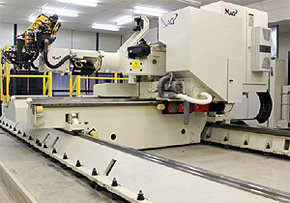

The enterprise will be focused on the development of lighter, more durable low-cost parts for several sectors (IPT)
The enterprise will be focused on the development of lighter, more durable low-cost parts for several sectors.
The enterprise will be focused on the development of lighter, more durable low-cost parts for several sectors.

The enterprise will be focused on the development of lighter, more durable low-cost parts for several sectors (IPT)
By Elton Alisson
Agência FAPESP – In 2014, the Brazilian aeronautics, auto and oil and gas exploration industries, among other sectors, will gain a new laboratory for development of light structures for manufacturing lighter, more durable low-cost parts.
The Institute of Technological Research (IPT) is concluding construction of the Light Structures Laboratory (LEL) in the São José dos Campos Technological Hub in upstate São Paulo.
Slated for inauguration in December 2013, the laboratory received R$ 48 million in investments. The Brazilian Development Bank contributed R$ 27.5 million of this sum for acquisition of equipment and construction of the laboratory. The Brazilian Innovation Agency (Finep) invested R$ 8.3 million, and the São José dos Campos Municipal Government invested R$ 2.5 million, with the support of the São Paulo State Secretariat of Economic Development, Science and Technology.
The rest of the investment, roughly R$ 10 million, was contributed by the IPT and FAPESP, which support the laboratories’ four major structural research projects.
“The laboratory is in the final stages of construction. Some equipment has already been installed, and the clean room [a 1,600- m2 area with temperature, humidity and particulate control] is being built,” commented Luiz Eduardo Lopes, director of the IPT Center for Structural Integrity and Equipment, with which LEL is affiliated.
Lopes participated in a June 4 workshop on composites and light materials for industrial applications held at FAPESP. Organized by the IPT and Germany’s Fraunhofer Institute, the event’s objective was to discuss experiences and strengthen the relationship between Fraunhofer and the Light Structures Laboratory.
The laboratory will have a total area of 4,500 m2 and will be dedicated to the development of light structures made of metallic materials (such as steel, aluminum and titanium), composites (made of polymers reinforced by some type of fiber, such as carbon, glass or cellulose) and hybrids (combinations of these two types of materials).
These three classes of materials are currently the most widely utilized in the development of light structures. “When we talk about light structures, one immediately thinks of composite material. But light structures can be made of diverse materials that have the necessary resistance and afford a reduction in the desired weight,” explained Lopes.
For example, automobile monoblocks are light steel structures. Windmills for energy generation are made of composite materials and metallics. Many parts of airplanes are made of aluminum and titanium.
To increase the efficiency of airplanes, aeronautics industries have begun in recent years to utilize more composites in their projects, because they are more durable and lighter than the materials used before. However, composite materials still have limitations with respect to utilization in some parts of the structures of aircraft.
“The composite still has not reached a good enough point of technological maturation for it to be used in structures with the safety requirements of the aeronautics sector,” notes Sérgio Frascino Müller de Almeida, professor of the Technological Institute of Aeronautics (ITA) and coordinator of research projects on composite aeronautics structures conducted with FAPESP funding.
According to Almeida, to be more efficient, commercial airplanes need longer wings, and composites represent the best technological solution for this because they are lighter than aluminum.
The material, however, is not an energy conductor and has low thermal conductivity. When struck by lightning, an airplane wing made from composites can be damaged or overload the airplane’s circuits, causing control equipment to burn out. This is a hazard because fuel is stored in the wings. Almeida explained that this does not happen with aluminum wings, which, when hit by lightning, conduct electricity along the fuselage without causing structural damage.
To resolve this problem, one of the subjects of the project on aeronautical structures made from composite materials is the impact of lightning on this type of structure.
This project is being conducted by ITA researchers, in collaboration with the Universidade de São Paulo’s Polytechnic School (Poli-USP), USP’s Energy and Environment Institute (IEE), the São Carlos School of Engineering (EESC-USP), the Universidade Estadual de Campinas School of Electrical Engineering and Computing, the Universidade Estadual Paulista’s Guaratinguetá School of Engineering (FEG-Unesp), Embraer and IPT.
In addition to the aeronautics sector, composite materials are also applicable to several other sectors, such as aerospace, oil and gas, automobiles and aeolic energy—all of which the IPT laboratory is intended to serve.
Republish
The Agency FAPESP licenses news via Creative Commons (CC-BY-NC-ND) so that they can be republished free of charge and in a simple way by other digital or printed vehicles. Agência FAPESP must be credited as the source of the content being republished and the name of the reporter (if any) must be attributed. Using the HMTL button below allows compliance with these rules, detailed in Digital Republishing Policy FAPESP.





